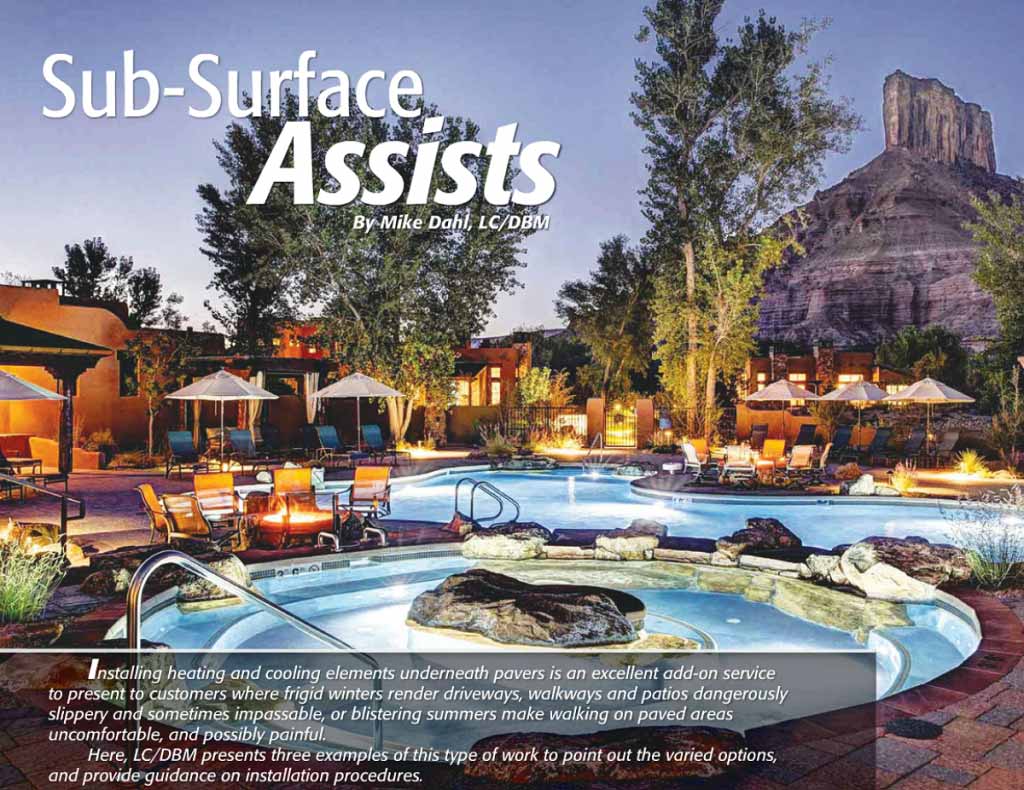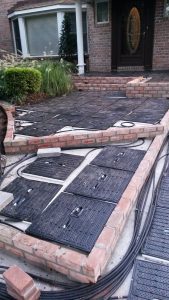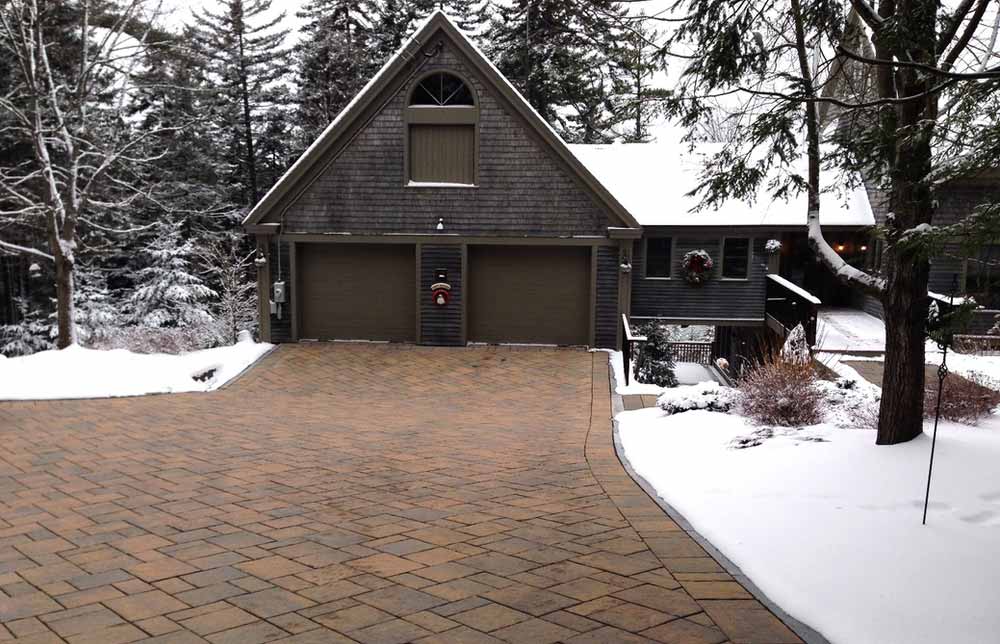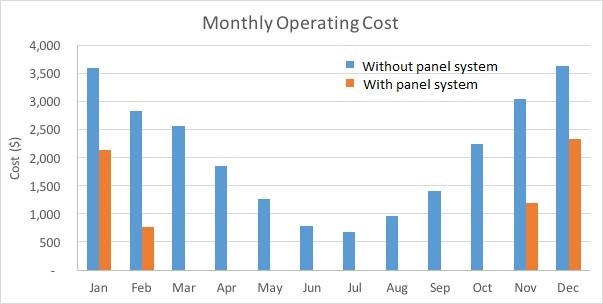An in-depth look into their effectiveness, installation, and added benefits.
Everyone knows that heating a pool can be a very expensive operation. That is why so many have moved towards sustainable technologies like solar energy. For most, when thinking of solar energy, an image of large solar panels comes to mind. Very few think of invisible solar heating, and that is because it is a relatively new technology. How could one potentially harness the energy of the sun without solar panels? Well, that is what this article will discuss.

Gateway Canyons Resort, Colorado
Thermal Batteries in Unexpected Locations
When walking along a driveway, or a backyard pool patio, or even a backyard deck, it is often very clear how much energy the sun puts out. Paver, brick, or stone, and even wooden patio temperatures often exceed 150 degrees Fahrenheit (enough to burn skin within seconds) simply due to exposure to the sun. This can occur even on relatively cool days. On hot days, paver temperatures are known to exceed 180 degrees Fahrenheit (enough to burn skin on immediate contact). With these types of temperatures, beautifully designed spaces can not only become uncomfortable, but even dangerous. In cooler climates, pool temperatures can remain low, leaving patrons cold in the water, but with burning feet upon exiting the pool. Fortunately, there is a solution that capitalizes on the thermal energy stored in these hardscapes and other sun-exposed surfaces.
Stone, bricks, and paver surfaces are capable of holding significant thermal energy from the sun, and extracting that energy will not only cool the surface down, but it will allow for the use of that energy elsewhere. This is what invisible solar pool heating is capable of. In other words, surfaces are used as thermal batteries, in which below-ground solar collectors can pull that energy out and use it elsewhere.
How does it work?
A below ground solar pool heater is a hydronic system. By circulating fluid (glycol and water mix) through panels located under the paver surface, the fluid is heated up, passed through a heat exchanger, and the heat is transferred to the pool, spa, or domestic hot water. This will in turn cool patio temperatures to comfortable and safe levels. Modular hydronic systems are capable of very efficient heat transfer, and therefore can very effectively capture the thermal energy stored in paver, stone, brick, or deck surfaces.
In most cases, pools have a desired temperature to be kept at. The hydronic system is capable of automatically circulating fluid to heat the pool to the target temperature when necessary, and stopping when that temperature is reached.
What happens when the pool gets too hot?
If the pool reaches the target temperature, fluid will stop circulating through the panels. This will prevent the system from further heating the pool, but will also stop the cooling of the patio. In a case where patio cooling is necessary, the system can have an alternative location to dump heat energy, like a pond, or domestic water to allow the system to continue to cool the patio even when the pool does not need to be heated. If the project is such that there is no excess heat dump and there is an excess of thermal energy from the system, a chiller can be installed to cool and compensate for the excess heat energy. This is of course only necessary when patio cooling is essential. It also must be noted that in the design of a system, all of these scenarios can be mapped out based on the climate of the pool location, size of the pool, the color of pavers, the material of pavers, target pool, and patio temperature and other attributes. This type of mathematical planning will be able to determine if a location would need a chiller, a pool heater, or if a location could ever run into issues with excess or deficient thermal energy. Analysis can also determine the return on investment (ROI) of a project.
When there isn’t enough thermal energy?
When there isn’t enough thermal energy to heat a pool to the target temperature at any specific time, a pool heater can make up for the difference. Even when this is necessary, a solar system can still make sense as it can potentially cut pool heating costs enough to elicit a very fast ROI. Every type of pool heating system has different operating costs with the most expensive often being electrical. Replacing an electrical system with a hydronic system will give the owner the fastest ROI, while a slightly slower ROI will be witnessed with a gas heater.
How is it installed?
A hydronic system is usually installed by a mechanical contractor or plumber. The hydronic system manufacturer provides onsite training for the installer ensuring a proper and efficient installation. The hydronic system installer (mechanical contractor, plumber, etc.) will work closely with the paver installer (hardscape installer, landscape contractor, roofer, etc.) so that the entire process is coordinated.
For a pedestal-mounted system, the paver installer will set the pedestals to the correct height. Following this, the panel installer will place the panel rows on top of the pedestals and adjust them accordingly. The paver installer will then follow the panel installer so that the pavers can be placed on top of the panel.
An on-grade system follows a very similar pattern. First, the paver installer will prepare the ground surface (sub-base) for typical paver installation (keeping in mind the height differential due to the hydronic system). The panels will be set, connected, and tested by the contracted installer. Setting the panels is easy, as they will be delivered in factory-connected and labeled rows. They will simply layout and unfold into place, where they can be adjusted accordingly. Once the panel system is laid on the sub-base, tested, and connected to the manifolds, the paver installer can add bedding sand and continue with paver, stone, or brick patio installation.
 Installation of the panel system is very similar to tube-based snowmelt systems. However, because each row is custom-made to the plan’s specifications, laying out rows and making connections is faster and simpler than tubing systems. Often, driveways installed with panel systems can be done before lunchtime. With tubing installation, a similar project may take a couple of days.
Installation of the panel system is very similar to tube-based snowmelt systems. However, because each row is custom-made to the plan’s specifications, laying out rows and making connections is faster and simpler than tubing systems. Often, driveways installed with panel systems can be done before lunchtime. With tubing installation, a similar project may take a couple of days.
On grade, installations are required to have an ICPI approved sub-base, with a thin ¼” layer of sand on top of the base to fill any voids in the rough base material. A panel system provides structure to the base (acting as a second sub-base) and adds full support to the paver array. It is advisable to pre-compact the sand into the joints and crevices between the panels. This can be done using a Vibraplate with a plastic base or a hand tamp.
One major advantage to the panel system is that installations remain within ICPI guidelines. The panel acts as a second sub-base, allowing for a very thin layer of sand over the top of the system. Installing tube systems entails adding a layer of sand that is outside of the guidelines, meaning the pavers will no longer be covered by a warranty. This is a major issue, as tubing systems often cause settling, or cracking and spalling due to uneven heating.
Full Integration
When using a grate-type support system mounted on a wood-framed deck or pedestals, any type or size of paver, brick or stone can be applied over the system.
Wood-framed decks can also be configured to support hydronic panels with just the framing and then wood, PVC, or another synthetic decking can be applied over the panels and fastened to the framing located between the panels.
Adding a New Dimension to Design
Below ground solar pool heaters, patio coolers, and snow melting systems add a new dimension to design. By supplying designers and architects with a tool that increases the functionality of a space, extends the season of space, or otherwise makes a space more useful, the designers are able to incorporate more into the space. Hardscape professionals are capable of integrating this type of system with any surface, pedestal, on grade, raised patios, and more. This allows nothing to hinder design, even climate conditions, providing endless opportunities for a private backyard, company space, or public area. Homeowners or commercial property owners can find new uses for their spaces while being more energy conscious and potentially saving money in the long run.
Hydronic Setup
Most of the time, the plumber or mechanical contractor will be in charge of installing a system, so piping, manifolds, pressures, and heat loads are of minor concern to the hardscaper. Fortunately, a system of this type is pre-designed by the manufacturer with specified pumps, pressures, and layouts, making the install seamless, as it is well thought out and planned ahead. Any concerns with equipment compatibility will be addressed by the manufacturer, therefore leaving nothing in question.
Other Capabilities:
 ThermaPANEL Snow Melting System in Maine
ThermaPANEL Snow Melting System in MaineSnowmelting
One of the most important features of this type of system is snow melting. Because of the panel design of this system, it remains in contact with a much larger portion of surfaces than tube systems, which will prevent uneven heating. Uneven heating is known to cause many issues in surfaces as it promotes cracking and spalling. By providing even heating across surfaces, better and more efficient heat transfer is achieved. This will allow for lower operating temperatures, assisting in a more energy-efficient operation and faster heat transfer. This will also increase a paver’s lifespan as it will not be exposed to uneven heating and cooling.
When incorporated on a property with a pool, the system is still capable of heating the pool during the summer months via solar energy, and in the winter, warm fluid is snowmelting the area in which the panels are installed. This type of dual functionality leaves many property owners with an interesting solution. By installing a below-ground solar hydronic system under their driveway, they are capable of maintaining a snow and ice-free driveway, while also effectively heating the pool in the warmer months.
The snow melting feature of the system is in need of warm fluid to circulate through the panels. This involves tapping into existing boilers on a property to draw some energy. This again is planned out by the manufacturer, making sure all issues are addressed well ahead of time.
Other Uses
- Radiant heating and cooling of interior spaces
- Geothermal heating and cooling
- Chilling and refrigeration

Figure 1: Graph of monthly heating fuel cost, with and without using the heat gained from the installed solar system.
In Figure 1 above, the vast energy savings from adding the below ground system can be seen. Pool heating costs without the system supplemental heating were $24,850 for the year. With a solar system the yearly heating cost is $6,416, a savings of over $18,000.
All numbers are based on estimations of BTU outputs through experimentation and gathered public data of climate and weather conditions. Therefore all numbers are the best possible estimations but are not guaranteed accurate.
